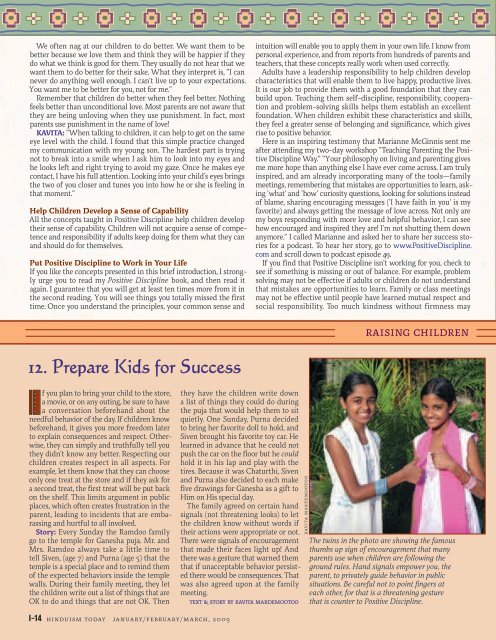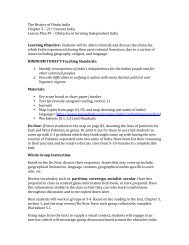Hinduism Today January 2009 - Cover, Index, Front Articles
Hinduism Today January 2009 - Cover, Index, Front Articles
Hinduism Today January 2009 - Cover, Index, Front Articles
You also want an ePaper? Increase the reach of your titles
YUMPU automatically turns print PDFs into web optimized ePapers that Google loves.
We often nag at our children to do better. We want them to bebetter because we love them and think they will be happier if theydo what we think is good for them. They usually do not hear that wewant them to do better for their sake. What they interpret is, “I cannever do anything well enough. I can’t live up to your expectations.You want me to be better for you, not for me.”Remember that children do better when they feel better. Nothingfeels better than unconditional love. Most parents are not aware thatthey are being unloving when they use punishment. In fact, mostparents use punishment in the name of love!Kavita: “When talking to children, it can help to get on the sameeye level with the child. I found that this simple practice changedmy communication with my young son. The hardest part is tryingnot to break into a smile when I ask him to look into my eyes andhe looks left and right trying to avoid my gaze. Once he makes eyecontact, I have his full attention. Looking into your child’s eyes bringsthe two of you closer and tunes you into how he or she is feeling inthat moment.”Help Children Develop a Sense of CapabilityAll the concepts taught in Positive Discipline help children developtheir sense of capability. Children will not acquire a sense of competenceand responsibility if adults keep doing for them what they canand should do for themselves.Put Positive Discipline to Work in Your LifeIf you like the concepts presented in this brief introduction, I stronglyurge you to read my Positive Discipline book, and then read itagain. I guarantee that you will get at least ten times more from it inthe second reading. You will see things you totally missed the firsttime. Once you understand the principles, your common sense andintuition will enable you to apply them in your own life. I know frompersonal experience, and from reports from hundreds of parents andteachers, that these concepts really work when used correctly.Adults have a leadership responsibility to help children developcharacteristics that will enable them to live happy, productive lives.It is our job to provide them with a good foundation that they canbuild upon. Teaching them self‐discipline, responsibility, cooperationand problem‐solving skills helps them establish an excellentfoundation. When children exhibit these characteristics and skills,they feel a greater sense of belonging and significance, which givesrise to positive behavior.Here is an inspiring testimony that Marianne McGinnis sent meafter attending my two-day workshop “Teaching Parenting the PositiveDiscipline Way.” “Your philosophy on living and parenting givesme more hope than anything else I have ever come across. I am trulyinspired, and am already incorporating many of the tools—familymeetings, remembering that mistakes are opportunities to learn, asking‘what’ and ‘how’ curiosity questions, looking for solutions insteadof blame, sharing encouraging messages (‘I have faith in you’ is myfavorite) and always getting the message of love across. Not only aremy boys responding with more love and helpful behavior, I can seehow encouraged and inspired they are! I’m not shutting them downanymore.” I called Marianne and asked her to share her success storiesfor a podcast. To hear her story, go to www.PositiveDiscipline.com and scroll down to podcast episode 49.If you find that Positive Discipline isn’t working for you, check tosee if something is missing or out of balance. For example, problemsolving may not be effective if adults or children do not understandthat mistakes are opportunities to learn. Family or class meetingsmay not be effective until people have learned mutual respect andsocial responsibility. Too much kindness without firmness maydinodiaA family has their new car blessed.There are many such opportunitiesin our religion to reinforce thepresence of the Gods and guru inthe lives of our children. Guidingthem to follow a daily religiousroutine is a vital part of upbringing.become permissiveness, and too muchfirmness without kindness may becomeexcessive strictness.Sometimes we have to stop dealingwith the misbehavior and heal therelationship first. Often the healinginvolves encouragement that removesthe motivation for misbehavior withoutdealing directly with the misbehavior.Encouragement may not seemto work until adults understand thebelief behind the child’s behavior byrecognizing the mistaken goals.There is never just one way to solvea behavior challenge. In parent andteacher study groups, participants canbrainstorm several possible suggestionsbased on the principles in thebooks. The parent or teacher seekinghelp can then choose the most acceptablesuggestion. You can also sendquestions to my blog, where I post12. Prepare Kids for SuccessIf you plan to bring your child to the store,a movie, or on any outing, be sure to havea conversation beforehand about theneedful behavior of the day. If children knowbeforehand, it gives you more freedom laterto explain consequences and respect. Otherwise,they can simply and truthfully tell youthey didn’t know any better. Respecting ourchildren creates respect in all aspects. Forexample, let them know that they can chooseonly one treat at the store and if they ask fora second treat, the first treat will be put backon the shelf. This limits argument in publicplaces, which often creates frustration in theparent, leading to incidents that are embarassingand hurtful to all involved.Story: Every Sunday the Ramdoo familygo to the temple for Ganesha puja. Mr. andMrs. Ramdoo always take a little time totell Siven, (age 7) and Purna (age 5) that thetemple is a special place and to remind themof the expected behaviors inside the templewalls. During their family meeting, they letthe children write out a list of things that areOK to do and things that are not OK. Thenthey have the children write downa list of things they could do duringthe puja that would help them to sitquietly. One Sunday, Purna decidedto bring her favorite doll to hold, andSiven brought his favorite toy car. Helearned in advance that he could notpush the car on the floor but he couldhold it in his lap and play with thetires. Because it was Chaturthi, Sivenand Purna also decided to each makefive drawings for Ganesha as a gift toHim on His special day.The family agreed on certain handsignals (not threatening looks) to letthe children know without words iftheir actions were appropriate or not.There were signals of encouragementthat made their faces light up! Andthere was a gesture that warned themthat if unacceptable behavior persistedthere would be consequences. Thatwas also agreed upon at the familymeeting.text & story by kavita mardemootookavita mardemootooraising childrenThe twins in the photo are showing the famousthumbs up sign of encouragement that manyparents use when children are following theground rules. Hand signals empower you, theparent, to privately guide behavior in publicsituations. Be careful not to point fingers ateach other, for that is a threatening gesturethat is counter to Positive Discipline.14 strategies parents need to know13. Try Limiting the ChoicesOne of the easiest and yet most powerfultools of Positive Discipline is “LimitedChoices.” You can actually guideyour children through their younger yearsby letting them make choices for themselves,so that they build character and individuality,while still retaining parental control of thesituation.Try putting two children in a candy storeand asking them to choose just one treat! Theyare overwhelmed by the options. Each watchesto see who got the best or bigger treat, and itends up being a competition, instead of a simplecandy treat.Now try it with “Limited Choices.” Tell thechildren that each may choose two pieces eachof two types of candy, one piece for themselfand the other for the sibling. You have let themchoose their own, but you have reduced thechoices from 50 to two, and you have avoidedthe competition—all in one sentence. They eachend up with four pieces of the same candies.This strategy can work for just about everything:“Would you like to ring the bell or decoratewith the flowers for this morning’s puja?”“Would you prefer a glass of water or a glass ofjuice?” Avoid asking, “What would you like towear?” “What would you like to drink?” Suchquestions invite conflict because the child maysay something that you do not agree with.Story: Before each family dinner or outing,Anuradha chose the appropriate outfit forher son and daughter. She would set out theclothes on the children’s bed and inevitablyface a storm of protest. One of them almost alwaysended up crying. One day Anuradha waschoosing her own outfit for an important dinner.She asked her husband what he liked. Hesurprised her by picking out two outfits, thensaying that she should make the final decision.She quickly picked her favorite and saw howeasy he had made it for her. She realized in thatmoment that she was frustrating her childrenby not respecting them enough to let themhave a say in their choice of clothes. Soon after,while preparing to go to their cousin’s house,she laid out three good choices for each childand left the room. No arguing, no tears!text and story by kavita mardemootookavita mardemootooKovishan couldn’t make up his mindwhich film to watch one evening. Whenmom asked him to choose between justtwo films, he was able to decide!I-14 hinduism today january/february/march, <strong>2009</strong> january/february/march, <strong>2009</strong> hinduism today I-15
















